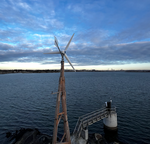News Release from Eneco B.V.
Wind Industry Profile of
Gulls avoid wind turbines Eneco Luchterduinen more often than thought
If they do move into the area where the blades are moving, they very often evade them successfully. Knowledge in the field of the impact of offshore wind farms on birds is still developing. The results of the studies make it possible to calculate the number of expected collision victims even more accurately for future wind farms and to apply solutions that further reduce the number of collisions.
At Eneco Luchterduinen wind farm, research has been carried out in recent years by Waardenburg Ecology – in collaboration with Dansk Hydraulisk Institut (DHI) – into the behaviour of birds, both on behalf of Eneco and the Offshore Wind Energy Ecological Programme (Wozep). The focus was on gull species such as the herring gull and the greater and lesser black-backed gull. Efforts were made to identify all the species, but this was not always possible due to the quality of the videos and so categories were specified such as 'unidentified gull'. Cormorants, kittiwakes, ducks and gannets were also observed. During the measurement campaigns, only two collisions were filmed, involving a herring gull and an unidentified large gull. Although the study is continuing to gather more data for further firmed-up conclusions, this suggests that the collision risk for gulls in offshore wind farms is low. The influence of different weather conditions was also examined. Finally, the total numbers of birds in and around the wind farm were counted in order to measure the evasion behaviour of gulls.
Two bird radars and four cameras were used for the studies at Eneco Luchterduinen, and field observations were carried out twice a month over a period of 48 months from several turbines in the park. Information was obtained about the activity of birds, such as resting, searching for food, flight altitude, flight speed and degree of evasion of a number of seabird species. Together, this has provided better data for the avoidance and collision models used by the government to provide insight into the long-term impact of offshore wind on ecology. The report on the study commissioned by Eneco can be found here. In the coming years, Wozep will continue to register collisions in Eneco Luchterduinen using cameras and radar in order to increase the reliability of research into this. Wozep is currently also conducting research into the behaviour of birds at other Eneco wind farms, such as Blauwwind’s Borssele III and IV wind farms.
In the future, comparable research using the new generation of bird radars and cameras will be carried out at Hollandse Kust West wind farm of the Eneco and Shell joint venture Ecowende. These radars can also collect flight altitude information automatically and the cameras have a higher image quality and can also film at night. They also have a longer range and better tracking of the birds thanks to artificial intelligence. This will make it possible to better understand the behaviour of the birds around offshore wind farms and to take more appropriate measures for birds.
- Source:
- Eneco
- Author:
- Press Office
- Link:
- news.eneco.com/...
- Keywords:
- Eneco, offshore, wind farm, wind turbine, gull, collisions, Luchterduinen, Netherlands, avoiding, camera, radar, solution, Waardenburg Ecology
























